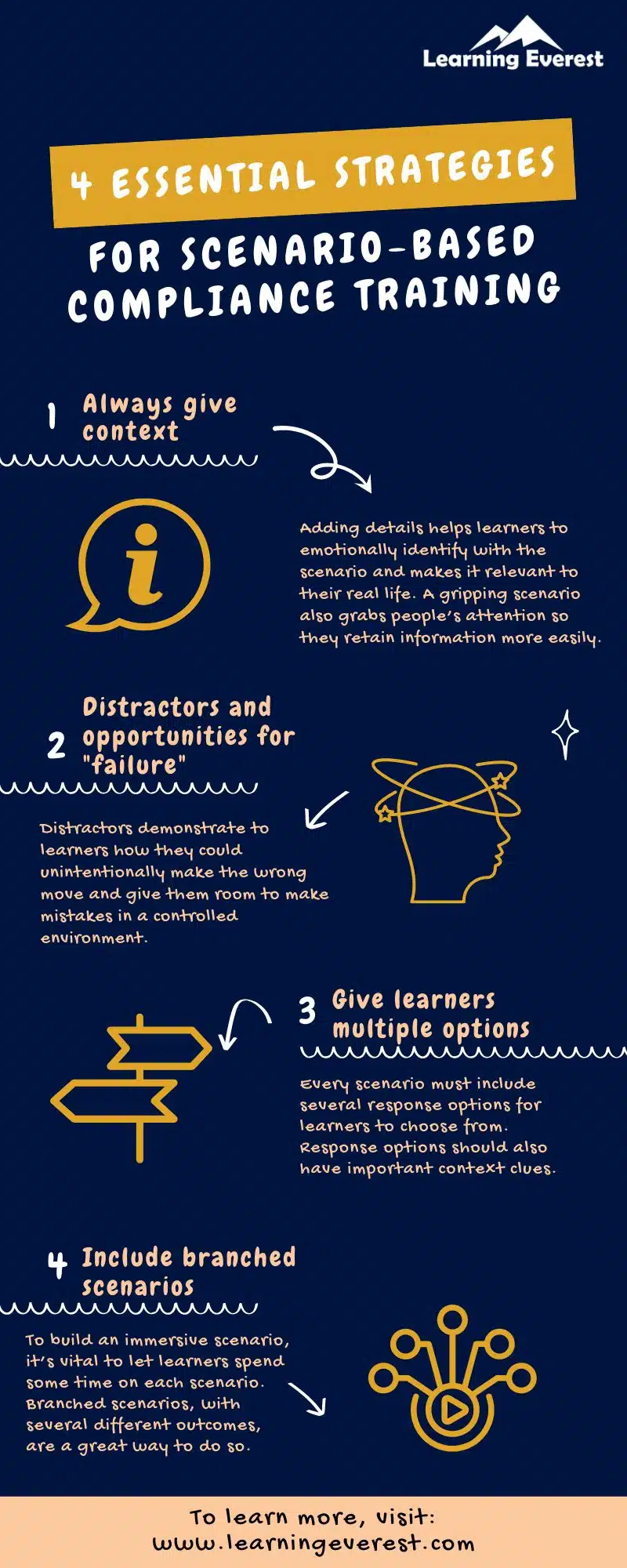Curious to know about the essential strategies for Scenario-Based Compliance Training? L&D leaders are always looking for ways to improve organizational training for better learning, engagement, and retention. Unfortunately, compliance training is one of those areas where all three of these conditions fail to be met. Scenario-based compliance training is an interactive, dynamic, and active approach to teaching compliance that can bypass this issue. This article will give you a brief overview of scenario-based compliance training and some strategies to implement it.
Scenario-Based Compliance Training: What is Scenario-Based Learning?
As the name evidently suggests, scenario-based learning (SBL) is a technique that uses scenarios to teach learners procedures, skills, rules, protocols, etc. SBL has the following features:
- A narrative or storyline that reflects a real-world situation
- A problem that learners need to solve
- Opportunities for learners to make decisions regarding the scenario and receive feedback
In scenario-based learning, learners essentially get to practice how they are expected to behave in the real world if the scenario occurs. It helps learners concrete problem-solving and decision-making skills regarding the subject matter and produces meaningful change in their knowledge, skills, and behaviors.
Why is Scenario-Based Compliance Training Effective?
Compliance training is a mandatory business protocol. However, employees and employers, both, tend to have unfavorable attitudes towards it. For leaders, compliance training is more of an obligation they need to check off their list to stay out of regulatory trouble. For employees, it is time spent finishing a boring and preachy training module.
Transforming some or all sections of these mandatory modules into scenario-based compliance training makes the otherwise dry and one-sided content engaging and interactive. When learners engage with information and have the opportunity for dynamic interaction, they also retain what they learn much better.
Additionally, imparting regulations using scenarios decreases the chances of accidental non-compliant behaviors occurring.
To sum up, scenario-based compliance training gives learners an opportunity to experience situations where they are required to make judgements and decisions about the right course of action to follow. Learning in such a way enhances their ability to identify and apply this knowledge in real settings.
Strategies for Effective Scenario-Based Compliance Training
Now that you know what SBL is and why it is effective, let us look at 4 essential strategies for every scenario-based compliance training program. These tips are the most fundamental requirements needed for constructing an effective SBL experience for learners.
Always give relevant context, details, and a set-up
When building a scenario, it is important to sprinkle it with details about the setting and context it is occurring in (compliance scenarios examples, compliance training scenarios). Some things to add are:
- Where the situation is taking place
- Who all are involved in the scenario
- What is the state of mind of the people involved
- Dialogues between characters
- Reiterations of the central conflict learners need to solve
Adding such details helps learners to emotionally identify with the scenario and makes it relevant to their real life. A gripping scenario also grabs people’s attention so they retain information more easily.
Distractors and Opportunities for “Failure”
A good scenario should also have some distractors that push learners to really understand the situation.
Distractors demonstrate to learners how they could unintentionally make the wrong move and give them room to make mistakes in a controlled environment.
The feedback these situations provide ingrains things to look out for in the learner’s minds, producing an effective behavioral change in them.
Give Learners Various Options for Each Decision They are Required to Make
The uniqueness of scenario-based learning lies in how learners get to reach the destination based on their own judgment. Thus, every scenario must include several response options for learners to choose from. Just as the scenario’s set-up should be rich and detailed, response options should also have important context clues to enable decision-making.
Include Branched Scenarios
To build an immersive scenario, it’s vital to let learners spend some time on each scenario. Branched scenarios, with several different outcomes, are a great way to do so. Branched outcomes also actively engage learners and help them observe the cause and effect of their choices and their consequences. Branching scenarios can also facilitate insight-based learning and “aha!” moments that the learner will remember for a long time.
Thus, narratives must be constructed even for wrong or less favorable outcomes instead of giving learners a verdict or the solution right away.
Infographics
Conclusion
Scenario-based compliance training is a great way to transform organizational compliance training conventions into fun and engaging training modules that produce learning that sticks. L&D departments and compliance heads can tailor these scenarios to fit organization-specific areas of non-compliance and deliver courses that are highly relevant for employees. Relevant training always produces long-lasting effects by allowing learners to identify with the subject matter, thus, SBL will elevate your organization’s conduct as a whole and make it a safer and more productive working environment for all.






